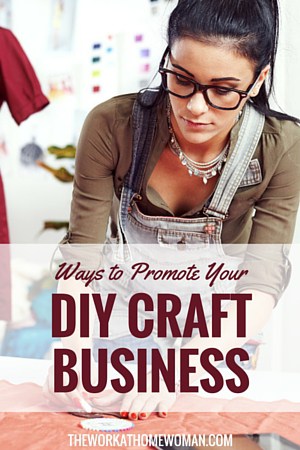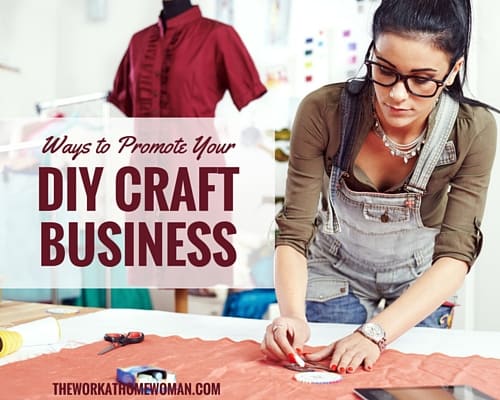Ways to Promote your DIY Craft Business
[ad_1]
 By Nisa Chavez Taylor
By Nisa Chavez Taylor
Savvy women with home-based craft businesses are often wearing many hats and embracing the DIY mentality of managing nearly all, if not all, parts of their business.
Whether you have a craft business to bring in side income or are wanting to ramp it up into a full-time endeavor, there are several ways to promote your shop, drive visibility to your brand and sell your hand-crafted work. There are several great strategies that you can employ to help promote your DIY craft business. However, you want to be strategic about which strategies you use.
Since you are doing everything yourself, you can’t possibly be everywhere all at once, and hope it all works. Focus on the channels and tricks that will bring you the most benefit.
In his book, The 4-Hour Work Week, entrepreneurial guru Tim Ferriss encourages using Pareto’s Principle to maximize productivity by focusing on just 20 percent of the areas that bring in 80 percent of the returns. If you focus on strategies that don’t end up bringing you much benefit or are torn in so many directions promoting your business that you fall short on pushing key channels, it will hurt you more than help you. Evaluate which strategies will work best for your business, and then target the customers you’re going after.
Let’s break down different ways to elevate your exposure and create positive brand awareness!
Online Marketplaces.
Selling handmade crafts and goods in online marketplaces is a great way to get traffic to your shop. Marketplaces that are popular will automatically bring potential customers to you, so half the work there is done! The other half of the work is still up to you to promote your shop and create quality products, product photos, descriptions, pricing strategy, etc.
The downside to online marketplaces is that you don’t have full control over the branding of your shop. You get the design functionality that fits into the brand of the marketplace in which you’re selling, and you are still co-promoting their brand.
Another downside is that marketplaces can seep away traffic that is being driven to your shop. If a potential customer chooses to click on a related key search term and navigate to another online shop, you miss out on a potential sale.
That being said, online marketplaces are a fantastic way to get exposure, and selling on more than one can increase your exposure to more potential customers, so long as you have the inventory to post products on multiple platforms.
Some great marketplaces on which to sell your DIY craft are:
The list can go on, so do a little research and find out which online stores are right for you. Note, you want to pick an online marketplace that is geared towards the customers to whom you want to sell. As a stark example, if you’re selling cozy handmade pillows for the home, you wouldn’t want to sell in an online art marketplace.
E-commerce Websites.
A website is essential if you want to start building a brand that you can promote. Beyond just a website, an e-commerce website enables sellers to promote their brand and sell products in their own online shop. Having an e-commerce website allows sellers to manage orders, track purchases, offer deals to customers, manage SEO, and get other useful information from the traffic to your store.
There are a variety of website builders perfect for e-commerce, such as:
Depending on your customization needs, e-commerce needs, and budget, you may want to choose one website builder or pricing plan over another.
If you’re starting out, Big Cartel and Zibbet have free plans to start selling right away, and if you’re ready to run an e-commerce craft business, you can use any builders’ paid plans. Big Cartel and Wix have limits on the number of product listings allowed and bandwidth storage, respectively, while Shopify, Squarespace, and Zibbet all have plans that offer unlimited product listings.
When you’re determining what website builder is right for you, address what specific needs of yours are most important for your specific business. Look at each builders’ transaction or listing fees, plan pricing, how customizable their web themes are, or how robust their e-commerce tools are.
Local Markets and Events.
Take your DIY craft business offline and sell at local markets and events like sidewalk artwalks. People can see your craft and meet you in-person. It creates a personal and intimate customer experience. Some booths at events cost money upfront to sell, so keep extra costs in mind if you are thinking of doing in-person events.
Another in-person event to promote your craft business is one you put on yourself, like a party! Here are some ideas to get you brainstorming.
Art, craft, and Music Festivals.
Art, craft, and music festivals bring the creative community together to create, share, and appreciate art in its many forms. Many people go to these kinds of festivals with the intention of purchasing something special and unique.
These are the perfect in-person events that will drive a lot of foot traffic to your booth and attract customers that will likely appreciate your craft and be willing to purchase it. Like local events, these events connect you directly with customers, giving you the opportunity to create a great experience for them.
Product Photos, Names, and Descriptions.
Having great product photos, names, and descriptions isn’t just important for driving sales. It’s also important for marketing your brand before sales even happen. Having beautiful, professional, and presentable products that let your brand shine are more shareable and buzzworthy than presentations that are mediocre or don’t do your products justice. Product photos should look professional, clear, and have quality or natural lighting (when possible), with a clean, minimal background.
Poor quality photos and presentation can reduce the perceived quality of your product to potential customers, so it is worth investing the time and effort into capturing great photos that are professional.
Sophia Amoroso, who founded Nasty Gal by selling vintage clothes on eBay and then turned it into a $100M business, is a presentation genius. She took vintage items and brought them to life using fantastic styling and photography. Sophia changed the product photos of one of her dresses that was only getting sold once a week, and it became a top-selling dress, with 400 dresses getting purchased in a week just from switching up the model!
People have different preferences for choosing product names. Some may want to choose a simple name or string of words to represent their product and then describe what it is and its features in the description. Others may want to include what the product is and features in the product name.
Ideally, product names should be simple enough that they are unique to the product and don’t have a lot of filler content that makes the presentation look unattractive, for example: “145Double_Shirt_Med*Tshirt*shirt*red.”
Inconsistent symbols and descriptions in the product name can make the it look clunky and unattractive. Product descriptions that are concise and describe the beauty of your product clearly are crucial to describing exactly what you’re selling and why it’s desirable.
Social Media and Advertising.
Give your brand a social media presence by posting regularly on channels on which your customers frequent the most. It may be a combination of a few of these platforms; note that not all social media platforms will be conducive for connecting with your target communities and engaging potential customers.
- Snapchat
You could also consider setting aside a budget for running ads on Google, Instagram, Facebook, or Twitter. However, be extra careful not to throw out your budget by investing in an ad platform that doesn’t target the right customers.
Reaching Out to Bloggers and Influencers.
Submit your e-commerce website and/or marketplace shop to craft and lifestyle blogs, especially before certain calendar events. Let bloggers that are relevant to your industry know about your shop and some event-inspired products (i.e. Mother’s Day, Valentine’s Day, Easter).
You can also reach out to bloggers that cover handmade and craft entrepreneurial stories and women in business stories and let them know about your shop and what you’ve learned from running a DIY craft business. This builds thought leadership and elevates your personal brand.
Guest Posts and Thought Leadership
Submit a guest post to tell others your story about running a DIY craft business, e-commerce for handmade items, or any useful tips and learning experiences. Sharing your story with other people will bring more exposure to your brand and position your as an expert.
You can showcase your expertise by giving back to the community and teaching others how to learn arts and crafts or how to start a DIY craft business. By giving back to communities in your space, you build relationships in which collaborations, partnerships, and mentorship can form. When you help the community, others who have run a business from home, who have had success doing e-commerce, and who face similar challenges of turning a profit from their craft will be more likely to help you.
Customer Testimonials and Photos.
To build credibility and community-driven marketing, get testimonials and feedback from customers that you can share on your website and social media. Get customers to post pictures of their purchased products on social media and use hashtags to start building community engagement around your brand.
There are many great ways to promote your DIY craft business. Some ways may work better than others, and you may need to tweak your strategy to find the best promotion that will bring more traffic, sales, likes, and visibility to your brand. Try different channels and see what works for you and your business. When you see a strategy not working, measure the outcome and keep trying to tweak it; then switch to a new strategy if you do not see results.
This takes a lot of work and patience, but experimenting until you find a strategy that works is better than sticking with a strategy or channel that isn’t bringing any value. When you find one that works, focus your resources and effort into it to promote your business the best way possible.
Nisa Chavez Taylor is PR Lead at Zibbet, a website builder and marketplace for artists, crafters, and makers. She loves learning and sharing insights about starting up, self development, and success. Find out more about Zibbet here.
This page includes affiliate links. Please be aware we only promote advertising from companies that we feel we can legitimately recommend to our readers. Please see our disclosure policy for further information.

[ad_2]
Source link




